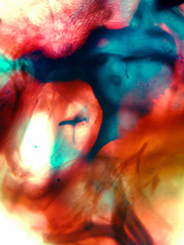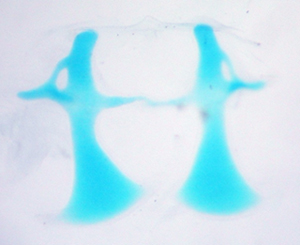| RIKEN Center for Developmental Biology (CDB) 2-2-3 Minatojima minamimachi, Chuo-ku, Kobe 650-0047, Japan |
May 18, 2012 –The vertebrate ear forms in three parts – inner, middle, and outer – that are derived independently from different embryonic tissues. In spite of these distinct origins, however, the adult ear manifests as a functionally integrated whole, suggesting that these regions must be closely coordinated during embryonic development. The precise manner in which this transpires, however, remains something of a mystery. In the case of the inner and middle ear, for example, the inner ear forms from a neuroectodermal primordium called the otic placode, followed by the middle ear, which arises from a migratory cell population derived from the neural crest. While the induction of the inner ear is fairly well understood, that of the middle ear, as well the integration between these neighboring tissue regions, is less clear. Now, YiHui Zou, Siu-Shan Mak, and colleagues in the Laboratory for Sensory Development (Raj Ladher, Team leader) have shed new light on this process, showing that an underlying strip of mesoderm is needed to induce the bony middle ear in chick. Published in Developmental Dynamics, this report opens up avenues toward an improved understanding of the ways in which organ systems involving multiple tissue types can be integrated during development.
In mammals, the middle ear is famously made up of three bones, known familiarly as the hammer, anvil, and stirrup, while in birds it comprises only a single bone, the columella. This structure arises from a neural crest-derived population of precursor cells, which at the relevant stage of development are surrounded by the inner ear, the pharyngeal endoderm, and the cephalic paraxial mesoderm (CPM). The first contact between the nascent columella and these tissues is with the CPM, at Hamburger-Hamilton stages 10—11, around 40 hours after fertilization. Zou and Mak decided to test whether this tissue would show inductive activity by transplanting mesoderm taken from the same site and developmental stage of quail embryos. Quail CPM from HH10 had no effect on chick columella, but when they did the same experiment using CPM from quail HH8 embryos, they found morphological changes in the recipient columella, which was interesting as this stage precedes that at which direct contact between these tissues occurs in normal development. The team speculated that the cephalic paraxial mesoderm might work indirectly by exerting an effect on another neighboring tissue that subsequently induces middle ear. Previous work had shown that CPM induces the otic placode, the tissue that gives rise to the inner ear, so Mak and Zou first tried ablating inner ear and watching for effects on columella development. Although some anomalies were detected in the fine structure of the ossicle, the effects were modest and suggested that the tissue mediating the CPM’s inductive action is not inner ear. They turned next to the pharyngeal endoderm (PE), which is known to act in the formation of other skeletal elements. Again using a classical explant approach, Zou and Mak transferred corresponding quail tissue into chick embryos and watched for changes in columella formation. When tissue from the second branchial arch (the site of origin for the middle ear) was transplanted from a HH10 quail embryos into chick embryos at the same stage, they observed a range of severe defects in middle ear development; transplants of other endodermal tissue had no such effect, suggesting that pharyngeal endoderm works specifically in this context.
Given that both the CPM and the pharyngeal endoderm affect columella tissue patterning, the team conjectured that CPM might be triggering inductive activity in the PE, which is known to express Fgf19, the signaling molecule primarily responsible for inner ear induction. Chick endoderm cultured in isolation did not show expression of this gene, but when this tissue was recombined with quail CPM, it was switched on, suggesting that endodermal Fgf19 is regulated by one or more signals from the cephalic paraxial mesoderm. “How organ systems with components derived from different lineages develop in a coordinated and integrated fashion has not really been investigated,” says Ladher. “The auditory system gives us some insight into one way that integration could happen.” |
|||||||
|
|||||||
 |
| Copyright (C) CENTER FOR DEVELOPMENTAL BIOLOGY All rights reserved. |

